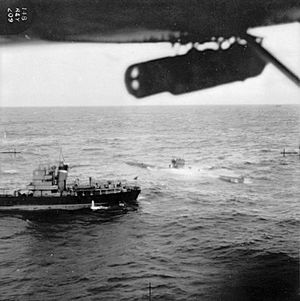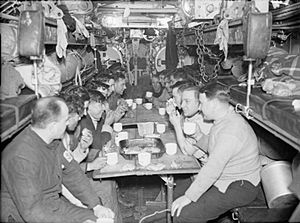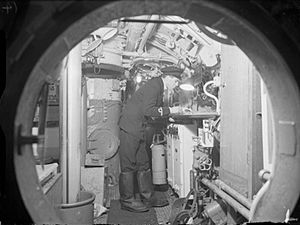HMS Graph facts for kids
class="infobox " style="float: right; clear: right; width: 315px; border-spacing: 2px; text-align: left; font-size: 90%;"
| colspan="2" style="text-align: center; font-size: 90%; line-height: 1.5em;" | 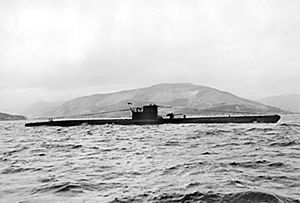
|}
HMS Graph (also known by its number P715) was a German Type VIIC U-boat that the British Royal Navy captured during World War II. It was first called U-570 and served in Nazi Germany's navy, the Kriegsmarine, starting in mid-1941. However, it was attacked and captured on its very first mission.
This submarine gave the Royal Navy and United States Navy important information about German submarines. It even went on three combat patrols with a British crew. This made it the only U-boat to serve actively with both sides during the war. It was taken out of service in 1944 because it was hard to keep it running. While being pulled to a scrapyard, it got stuck on the Isle of Islay, off the west coast of Scotland. Some parts of the wreck were removed, but some pieces are still there today.
Contents
| History | |
|---|---|
| Name | U-570 |
| Ordered | 24 October 1939 |
| Builder | Blohm & Voss, Hamburg |
| Yard number | 546 |
| Laid down | 21 May 1940 |
| Launched | 20 March 1941 |
| Commissioned | 15 May 1941 |
| Captured | Captured by the Royal Navy on 27 August 1941 |
| Name | HMS Graph |
| Namesake | Graph |
| Acquired | 27 August 1941 |
| Commissioned | 5 October 1941 |
| Decommissioned | 21 June 1943 |
| Fate |
|
| General characteristics | |
| Class and type | Type VIIC submarine |
| Displacement |
|
| Length | 67.10 m (220 ft 2 in) |
| Beam | 6.20 m (20 ft 4 in) |
| Draught | 4.74 m (15 ft 7 in) |
| Propulsion |
|
| Speed |
|
| Range | 8,500 nmi (15,700 km; 9,800 mi) |
| Test depth | 230 m (750 ft) |
| Armament | |
| Service record (Kriegsmarine) | |
| Part of: |
|
| Commanders: |
|
| Operations: |
|
| Victories: | None |
| Service record (Royal Navy) | |
| Commanders: |
|
How the Submarine Was Built
This submarine was built following the German Type VIIC design. When it was on the surface, it weighed about 769 tonnes (757 long tons). When it was underwater, it weighed about 871 t (857 long tons). The submarine was 67.10 metres (220 ft 2 in) long. It was 6.2 metres (20 ft 4 in) wide and 4.74 metres (15 ft 7 in) deep in the water.
The submarine used a diesel-electric system to move. This allowed it to go up to 18.8 knots (34.8 km/h; 21.6 mph) (knots) on the surface. Underwater, it could reach 7.6 knots (14.1 km/h; 8.7 mph). The U-570 could travel about 7,500 nmi (13,900 km; 8,600 mi) (nautical miles) at a speed of 10 knots (19 km/h; 12 mph). It could dive as deep as 230 metres (750 ft).
Its main weapons were five torpedo tubes, which fired 53.3 cm (21 in) torpedoes. Four tubes were at the front, and one was at the back. It could carry 14 torpedoes in total. It also had an 8.8 cm (3.46 in) deck gun and an anti-aircraft gun.
Blohm & Voss started building U-570 in Hamburg on 21 May 1940. The submarine was launched (put into the water for the first time) on 20 March 1941.
U-570 officially joined the German navy (the Kriegsmarine) on 15 May 1941. After some short test trips in the Baltic Sea, it moved to Norway. There, it did more training and practiced firing torpedoes. By 25 July, it was at the German U-boat base at Lofjord, near Trondheim.
In August 1941, German code-breakers found out that many Allied merchant ships were gathered south of Iceland. Admiral Karl Dönitz ordered 16 U-boats to that area. U-570 was one of them. On 24 August, it left for its first war patrol. Its mission was to patrol south of Iceland, then go to a U-boat base in France. It carried enough supplies for four weeks at sea.
Kapitänleutnant Hans-Joachim Rahmlow was the commander of U-570. He was an experienced officer but new to U-boats. Most of his crew were also new to submarines. Only a few had been on a war patrol before. This meant the crew of U-570 was not very experienced.
The Capture of U-570
On 27 August 1941, U-570 spent most of the morning underwater. The crew was suffering badly from seasickness. Earlier that day, a Lockheed Hudson bomber from the RAF (Royal Air Force) had tried to attack it. But the bomber's depth charges did not release.
U-570 came to the surface around 10:50 am. It surfaced right below another Hudson bomber, flown by Squadron Leader James Thompson. Commander Rahmlow heard the plane's engines and ordered a quick dive. But Thompson's plane reached U-570 before it could fully submerge. He dropped four 250-pound (110 kg) depth charges. One exploded very close to the submarine.
U-570 quickly came back to the surface. About 10 crew members came out. The Hudson fired its machine guns, but stopped when the U-boat crew showed a white sheet. The captured crew later told British officers what happened. The depth charge explosions had nearly flipped the submarine over. All electrical power was lost, instruments were broken, and water was leaking in. The air inside felt bad, and the crew thought it was poisonous gas from the batteries.
The crew in the engine room panicked and ran forward. This meant no one was left to fix the power. The submarine was stuck and dark. Commander Rahmlow thought it was too dangerous to stay underwater. So, he surfaced. The sea was too rough to use their anti-aircraft gun. They showed the white flag to stop another depth charge attack. They did not know the plane had already dropped all its bombs.
Most of the crew stayed on the submarine's deck. Thompson's plane circled above them. Another Hudson plane joined it to help. A Catalina flying boat was sent from Reykjavík. It arrived three hours later. The German crew sent a radio message to their navy, then destroyed their radio. They also smashed their Enigma machine and threw its parts and secret papers into the sea.
The British heard U-570's plain language radio message. Admiral Percy Noble quickly sent several ships to the area. By early afternoon, the Hudson planes had to return to Iceland for fuel. The Catalina, which could fly for a long time, was told to watch the submarine until Allied ships arrived.
The first ship to reach U-570 was the anti-submarine trawler HMT Northern Chief. It arrived around 10 pm, guided by flares from the Catalina. The Catalina then returned to Iceland after watching U-570 for 13 hours.
The German crew stayed on board U-570 overnight. They did not try to sink their submarine. Northern Chief had warned them that if they did, the British would open fire and not rescue anyone. During the night, five more Allied ships arrived. These included other trawlers and two destroyers, HMS Burwell and HMCS Niagara.
At dawn, the British and Germans exchanged messages. The Germans kept asking to be taken off the submarine, saying it was sinking. The British refused until the Germans made sure the submarine would not sink. They worried the Germans would leave behind a sinking U-boat. The situation became more confusing when a small float-plane appeared. It did not know about the surrender. It attacked U-570 and fired at Northern Chief, which fired back. No damage was done, and Burwell ordered the plane away.
The weather got worse. Several tries to attach a tow-line to U-570 failed. The British thought the Germans were being difficult. So, Burwell's captain ordered warning shots. These shots accidentally hit and slightly wounded five German crew members. An officer and three sailors from Kingston Agate managed to reach the submarine using a Carley float (a liferaft). They quickly searched for the Enigma machine but did not find it. They attached a tow line and took the five wounded men and the German officers to Kingston Agate. The rest of the crew went on board HMCS Niagara.
The ships slowly began sailing to Iceland with U-570 being towed. Hudson and Catalina planes flew overhead constantly. They arrived at Þorlákshöfn at dawn on 29 August. There, they pulled U-570 onto the beach because it was taking on water and seemed like it might sink.
Fixing and Studying the Submarine
Two days after U-570 arrived, a British submarine commander, Lieutenant George Robson Colvin, came from Britain with a team of engineers and experts. They started to examine and fix U-570.
Colvin's team was able to get the lights working and make the submarine float again. U-570 was then towed to the British naval base at Hvalfjörður. There, it was repaired next to the depot ship HMS Hecla. The goal was for U-570 to travel to Britain using its own power.
The British found that the depth charge damage was not too bad. There were leaks in some tanks and a small leak in a fuel tank. Some battery cells were cracked, and the front of the submarine was bent. Water had leaked in through a valve and broken glass gauges. Other damage was minor. They found no evidence of poisonous gas. Colvin believed that an experienced crew could have easily fixed the damage and stayed underwater.
After surrendering, the German crew tried to destroy instruments. But except for the radio and a torpedo computer, their efforts were not very successful. Many useful papers were not destroyed. They found copies of secret messages and their plain-language German texts. This was very helpful for the British team trying to break the Enigma code. They also found the U-boat commander's handbook. This book helped the British understand the German naval messages better.
U-570 spent three weeks at Hvalfjörður. It was repaired and went on short sea trials to test its engines and steering. From 23 to 26 September, two US Navy officers carefully inspected it. One of the submarine's torpedoes was taken off and sent to the United States.

On 29 September, the submarine left for the UK. A British crew, led by Lieutenant Colvin, was on board. It was escorted by HMS Saladin and HMS Kingston Agate. It sailed on the surface because its diving parts were damaged from being beached. Its arrival at Barrow-in-Furness on 3 October was filmed by news cameras and reported in the newspapers. The capture was later used in British propaganda. Other U-boat captures, like that of the U-110, were kept secret. But U-570's capture involved so many people and ships that it could not be kept a secret.
U-570 was put into a dry-dock at the Vickers shipyard in Barrow. Its repair was difficult because the front of the submarine was bent. This trapped four electric torpedoes in their tubes. Two officers from the Royal Navy had to get them out for examination. The dock was cleared while a volunteer shipyard worker cut the armed torpedoes free. One of the officers, Lt Martin Johnson, then removed the detonators from the torpedoes. This was very dangerous. For this brave act, he received the George Medal.
Squadron Leader Thompson, his bomb-aimer John Coleman, and Flying Officer Edward Jewiss (the Catalina pilot) all received the Distinguished Flying Cross. The captain of Kingston Agate, Henry L'Estrange, received the Distinguished Service Cross.
At first, it was not clear what would happen to U-570. Winston Churchill wanted to give it to the Americans for repairs. This would be good for propaganda and help get America more involved in the war. The Americans wanted it, but the Royal Navy disagreed. They also did not like Churchill's idea of having it serve in the Mediterranean with a Yugoslav crew. Instead, it joined the Royal Navy as HMS Graph on 5 October 1941. It was given the number P715. The name Graph started with 'G' to show it was German. It was also chosen because many "graphs" (charts) were made during its testing. It was also a play on the German word Graf, meaning "Count".
Testing the Submarine
Once Graph could sail, careful tests were done to measure everything about how it sailed and dived. Even the Zeiss binoculars found on board were tested.
The British found that Graph could safely dive to 230 metres (750 ft). This was much deeper than they thought for this type of submarine. At that time, British depth charges could only go down to 170 metres (560 ft). This meant German submarines could dive deeper than the British bombs could reach. So, depth charges were soon changed to go deeper.
Allied experts praised its design. Graph's extra machinery was on rubber mounts. This made it quieter by reducing sound in the hull. The British and Americans especially liked its Zeiss periscope. American officers suggested it should be copied quickly for the US Navy. Its underwater listening equipment was also much better than British ones. The main criticism was that the crew's living space was small and cramped. This would make long patrols difficult for the crew.
In mid-1942, the US Navy studied Graph closely. They were interested in a new, smaller submarine. Graph was considered better than their existing small submarines. However, the project was later stopped.
Full-size models of Graph's main hull were built. These were used in mid-1942 to test new anti-submarine bombs. In a secret British project, Graph was also used to build three full-size models of a U-boat's control room, officers' mess, and radio room. These were used to train special groups of sailors. These sailors would board damaged U-boats that were forced to the surface. They learned how to operate the U-boat's valves to stop it from sinking. They also learned to quickly search for secret code equipment and documents.
Active Service
After finishing its tests, Graph was commanded by Lieutenant Peter Barnsley Marriott. He had helped with the tests. It left Holy Loch for its first Royal Navy war patrol on 8 October 1942. It was going to patrol the Bay of Biscay.
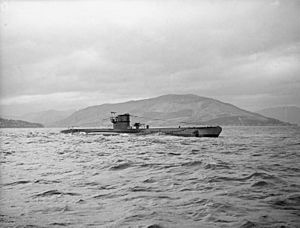
On 21 October 1942, Graph dived to avoid a German patrol plane. Marriott heard a loud sound and thought another submarine had also dived. Twelve minutes later, he saw its tower against the setting sun. Graph chased the German boat and fired four torpedoes. Explosions were heard, and also banging noises. The British thought they had hit the other submarine and it was breaking apart. In early 1943, Marriott received the Distinguished Service Order for his "courage, skill and determination".
After the war, German records showed the submarine attacked was the U-333. It had been badly damaged earlier. German lookouts saw the torpedoes coming and avoided them. The torpedoes then exploded for unknown reasons. The commander of U-333 later said the rattling noises Graph's crew heard were from his submarine's earlier damage.
Graph's second war patrol was from 19 November to 8 December 1942, also in the Bay of Biscay. It was ordered to stop an Italian cargo ship, Cortellazzo. But Graph did not find the ship. The patrol had no other incidents. The Cortellazzo was sunk a few days later by a British destroyer.
Graph left Lerwick for its third war patrol on 24 December 1942 with three other British submarines. Their job was to patrol off the coast of Norway. On 1 January 1943, it saw the German heavy cruiser Admiral Hipper. The cruiser was returning from an unsuccessful attack on a convoy. Hipper was too far away and too fast to be attacked. Later, Graph saw two German destroyers moving slowly. Graph got closer and fired four torpedoes. Again, explosions made the British think they had hit and sunk a destroyer. But again, all the torpedoes missed. Graph returned to Lerwick on 13 January 1943.
Graph did not go on any more war patrols. In 1943, it was used for training. Peter Marriott went on to command another submarine and received another medal.
Taken Out of Service
Problems with Graph, and a lack of spare parts, led to it being put into reserve. Its batteries and engines also wore out faster than British ones. German submarine batteries needed to be replaced every year, unlike British ones which lasted longer.
It was officially taken out of active service on 21 June 1943. It was then used as a target to see how much damage depth charges could cause. After surviving these tests, it was supposed to be towed to a scrapyard. But on 20 March 1944, its tow-rope broke in strong winds. It was pushed by the wind and waves and ran aground (got stuck) near Coul Point, on the west coast of Islay, Scotland. The tugboat could not pull it free, and it was left there.
Graph was partly salvaged and scrapped in 1961. In 1966, some more of the wreck was removed. Some parts of HMS Graph were still visible at low tide in 1970. Today, the remains of the wreck are in about 5 metres (20 ft) of water. Divers have visited and photographed the site.
One of the German battle flags from U-570 was given to Squadron Leader Thompson. It is now at the RAF Museum. Other items from the submarine include its typewriter, which is at the museum at Bletchley Park. A small globe used for navigation is owned by a private collector. A German sailor's cap, taken as a souvenir, is in the Canadian War Museum. Another battle flag is said to be owned by someone who worked at the Vickers shipyard.
See also
- List of submarines of the Second World War
- HMS Meteorite – This was a German experimental submarine used by the Royal Navy after the war.
- HMS Seal (N37) – A Royal Navy submarine that was captured and used by the Germans.
- HM Submarine X2 – An Italian submarine captured and used by the Royal Navy.
- U-1105 – A German U-boat that was used by the Royal Navy between 1945 and 1946.


